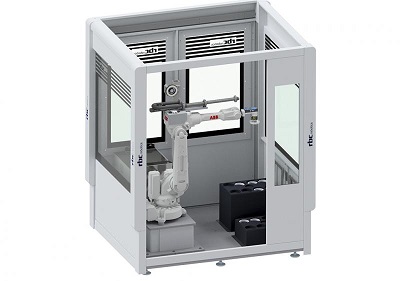
Camera guided loading and unloading system from DVS automation specialist rbc robotics
Not far from the premises of rbc robotics, the International Federation of Robotics (IFR) in Frankfurt am Main, Germany, has discovered how trends such as shorter product life cycles or low-volume/high-mix production entail faster commercial launches.
These so-called “trends” do seem quite familiar though, because the trends as such have not changed much over the past couple of years. Or at least that’s what it looks like. How does a shorter life cycle affect the actual product? Why do diminishing quantities undergo these fast changes? And how do we adapt to trends which seem to be stable but expect us to be flexible at the same time?
Stricter end product requirements such as an increasing variant diversity, the ability to be customised down to single user level or tighter quality standards are already reflected at the beginning of the production processes. Every part, whether unmachined or finished, needs to smoothly and perfectly adapt to trends such as high-level flexibility and especially faster responses to changing market demands. In order to survive on the market, production processes of small and medium-sized enterprises are especially subject to higher automation and scalability needs.
Intelligent concepts based on specific know-how
In response to increasing flexibility requirements, rbc robotics – the vision-guided robotics experts – have rethought complex automation processes with a view to modularity. After more than two decades of providing the European market with their solutions, the product portfolio of rbc robotics is almost unique not only regarding the process and programming technology but also in terms of economic aspects. This involves everything from robot programming, process visualisation, control unit design, planning and engineering, simulation and production to installation and commissioning: For rbc robotics a perfect cost-value solution integrates existing systems or components as well. Advisory services rendered by rbc robotics start at field level and, thus, at the basic automation needs to put together a modular portfolio which automatically adds value across the entire production process.
Vision-guided robotics benefit parts handling
But what exactly are the benefits of a system solution involving both cameras and robots? Compared to conventional parts feeding solutions, a combination of robot and camera is marked by several quite significant advantages. These kinds of vision-guided robot systems specifically excel in shorter rigging times and top-level flexibility.
Rigging times are becoming shorter and negligible
Since the robots’ camera system has a large field of view (up to 1200 mm x 800 mm are supported), it is able to detect parts and analyse picking coordinates without components having to be in an exactly defined place for robots to be able to pick them up. This very much facilitates the design of component feeding and placing processes. There is no need for mechanical retooling as required in a product carrier circuit, for example. If 2½D or 3D systems are used, components can even be picked directly off the pallet. Another advantage is that component-specific grippers can be changed fully automatically, thus making rigging times a negligible matter.
Increased flexibility enables immediate responses
An extremely fast initial detection of new parts creates a very adaptive system. A brief intuitive teach-in phase is all it takes to enable the system to directly inform the robot about the position and orientation of parts. Even customers without any programming experience can teach their system the new parts in just five to ten minutes. These systems are thus able to respond to changed parts extremely quickly. Generally, some detection parameter settings would simply have to be modified to make the robot correctly and reliably pick the changed parts again.
More reliability, flexibility and efficiency
Combining robots and cameras thus produces safer, more flexible and efficient processes and is therefore what the system solutions from rbc robotics are based on. When it comes to parts handling, they also rank among the safest modules of economically efficient process automation. Wherever standardised or extremely customised robotic solutions are needed, the concepts of rbc robotics are the perfect answer to all customer requirements. The team will design, draft and engineer system solutions that will do exactly what they should: make production fast, reliable and cost-efficient – at 100% quality.
Mercurial Victory CR7 Low
 iConnectHub
iConnectHub
 Login/Register
Login/Register Supplier Login
Supplier Login


























